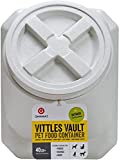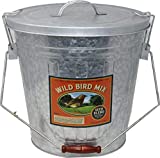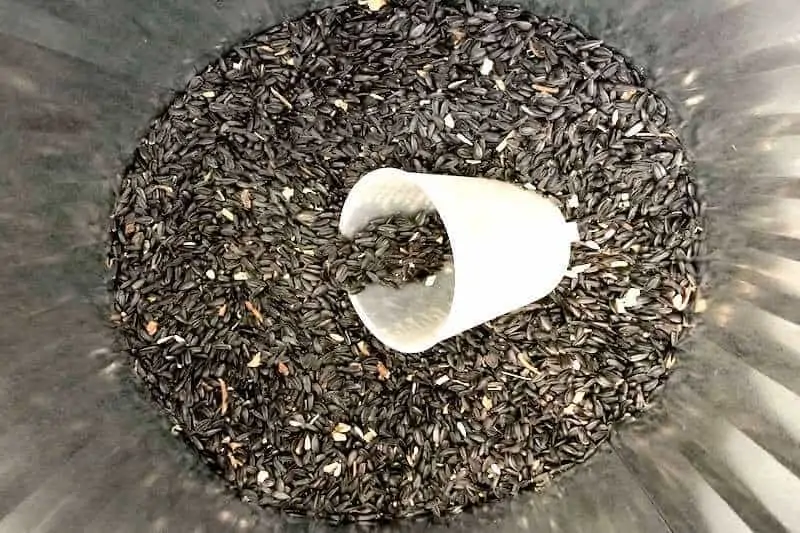You may have experienced a moment when you wished you knew more about birdseed if you enjoy feeding birds.
Is there a shelf life for bird seed? How can I tell if the seed is abnormal? How should I preserve my seed? Should it stay inside or out? If you’re a value buyer who is looking for good bulk discounts on large volumes of bird seed, there are a lot of factors to consider. You may be curious about how to store it all and how long it will stay current. We’ll take a look at all of these issues and tricks on how to store wild birdseed in this article.
HOW TO STORE WILD BIRDSEED – 3 WAYS
Containers make it simpler to scoop, conserve space, and protect the seed from environmental elements and mice, thus keeping it in the bag is usually an choice. The three most common types of birdseed storage containers are shown below.
STACKABLE AIRTIGHT FOOD STORAGE CONTAINER

Bird seed fits nicely in this pet food container. To help keep moisture out, it has an airtight seal, and the entrance is wide and easy to use. If you buy a few different types of seed, you can purchase multiples and stack them on top of each other for space efficiency. I’ve read comments from consumers who claim that it isn’t totally chew-proof, so this may be a better choice for inside use.
AUDUBON GALVANIZED METAL STORAGE BUCKET

Outdoor seed storage can be done in this galvanized metal bucket. The metal is too hard for Pesky mice and rats to chew through, and the lid has clamps that keep it securely locked in place. It has a rustic charm and reviewers say it can hold a 20-pound bag of bird seed. A scoop is also included with this product.
IRIS AIRTIGHT FOOD STORAGE CONTAINER

The convenience of having wheels on this heavy-duty plastic tote is nice. As a result, you won’t have to drag the container when you want to relocate it. The transparent body makes your seed level simple to see, and it’s air tight to assist against moisture. From 12 quarts to 69 quarts, it comes in a variety of sizes. You can use it for “double containment” if you didn’t want to empty the bag out, since many reviewers place their entire bag of seed in here rather than emptying it.
CAN BIRDSEED GO BAD?
Unfortunately, this is the case. Seed can deteriorate to the point where it should be rejected. Exposing seeds to high humidity, such as standing water or extreme humidity, can render them unusable. Natural oils are present in seeds, giving them a significant amount of their nutritional value. However, oils can become rancid if they get too hot or humid. Mold and fungus, both poisonous to birds, may also develop on seeds.
Insects and rodents are also a major source of contamination. Bugs may enter birdseed bags, lay eggs, and spread an infestation by squeezing into tiny areas. Birdseed bags have been known to be chewed through byHungry mice, rats, chipmunks, and squirrels looking for a meal. The urine and feces of these animals might contaminate the seed.
Seed can also just get old, aside from spoilage and contamination. If left too long, the seeds become dry, brittle, and have minimal nutritional value for the birds if they are not replaced with fresh oils. Old seeds are avoided by many birds. Picky about eating old, dried-up nyjer seeds, goldfinches are well-known.
To avoid some of these potential issues, let’s take a look at some storage techniques.
5 TIPS FOR STORING WILD BIRDSEED
1. DON’T STOCKPILE
If you get a good deal on seed, it might be easy to purchase a big amount. Yet, if you strive to keep your supply below what the birds can consume in a few weeks, you’ll eliminate a lot of issues with storage space, spoilage, and old, dry seed. The usual guide lines are no longer than 2 weeks during hot and humid weather, and no longer than 4 weeks during cold weather, especially if you’re storing your birdseed outdoors.
2. REGULATE TEMPERATURE & HUMIDITY
When it comes to spoiling birdseed, humidity and dampness can cause a lot of issues. Seed needs to be stored somewhere cool and dry. I liked to put my seed inside the house or basement when I had room. Keeping seed inside avoids watering and animal infestation (usually). Garages and sheds, on the other hand, offer environmental stability in the event that this isn’t possible. It’s preferable to store the seed in a covered container in the shade if you must keep it outside.
3. FREEZE IT
Several people successfully store birdseed in the freezer to extend the life of their seed, which may sound unusual. Storing seed in the freezer might be a good option if you live in a humid environment or have frequent concerns about seeds becoming damp or buggy. Particularly if you have a second freezer in the garage, or even more freezer space. Make certain the seed is totally dry before freezing and utilize an airtight container. Freezing seeds may preserve them for months or even years.
4. DON’T MIX OLD AND NEW
Don’t combine old seed with new seed if you’re consolidating your seed in a bin or container. Before opening a new bag, use up the old seed. If the older seed had become contaminated, combining it with your fresh seed would contaminate your entire supply. Additionally, keeping your new bag closed until you really need to use it will help to keep it fresher for a little longer.
5. KEEP IT CLEAN
Avoid spilling seed in the area around your seed storage. Rodents and other creatures may be alerted to your hiding place by seed on the ground, and they may be drawn to try and raid it. You want to keep your containers clean as well. Before you replace the container with fresh seed, make sure you thoroughly wash it out if you ever throw out seed due to a fear that it has spoiled.

Our plastic bin didn’t make it outside, as evidenced by the photo. I guess squirrels or chipmunks, but who knows? I then moved to galvanized steel trash cans exclusively.
HOW TO TELL BIRDSEED HAS GONE BAD
Take a quick look at your seed supply and keep an eye out for these tell-tale signs of trouble before refilling your feeders.
- If you notice seeds in pooled water, this is a serious issue. However, on the seeds or inside your pottery, you might also see condensation. Spoiled food can be caused by any form of damp.
- Mold & Fungus: Anything that appears to be growing on the seeds’ surface should be examined. A fuzzy or slimy coating on the seeds, a powdery coating, or any other strange discoloration may all be manifestations of this.
- All birdseed should be rubbery and solid to the touch. The seeds have gone bad if they seem soft, squishy, or spongey.
- Dry seeds should flow loosely and smoothly. Clumpy Seeds: Hardened clumps suggest that the seeds got wet and there is a higher chance of spoilage, so if a clump breaks apart easily it’s safe to eat.
- Moths, beetles, and spiders are among the various insects that may infect seeds. Look out for both live and dead insects. It’s unlikely that a single bug would be a big deal if it’s discovered, but keep an eye out for more symptoms.
- Rodents are tenacious when it comes to accessing bird seed in chewed bags and containers. They might chew through a plastic container as well as the bag you brought the seed in. Look for chewing marks and holes.
- Smell: If the seed oil goes bad, it will emit a pungent, unpleasant odor. Spoiled seed is any fragrance that reminds you of wetness or mustiness.
- Don’t give birds sprouting seeds if you notice them sprouted or grown shoots. Once the seeds have started to sprout, birds will not eat them. You might also try growing them in your garden if you’d like to. Eventually, you might get plants that create their own birdseed!
CHECK SEED QUALITY IN THE STORE
Buying top-quality birdseed from the start is another way to ensure that your birdseed has a long life. Inspecting the seed at the store isn’t always possible. Many bags, on the other hand, have transparent plastic windows that allow you to view the seeds. It’s always a good idea to search for nice color, intact shells, and anything that looks suspect. You may observe dusty seeds or many sticks once you get the seeds home and open the bag, particularly in huge ‘value’ bags. It’s not unusual to get a handful of twigs in a bag, but if there are too many twigs or dust, it might indicate that the seeds are older and you should try another variety.
MAKE IT SIMPLE TO TRANSPORT YOUR SEED
Make sure whatever container you use is simple to move the seed from to the bird feeders, no matter what size. To make filling the feeder simpler, there are a variety of scoops and easy-pour containers available. I’ve always used collapsible spouts in these handled containers. The most helpful combination for others is a scoop and a funnel. To prevent introducing any contaminants into the seed, whichever scoop you choose should be designated for birdseed only.
